Urbanization Effects on Vegetation and Surface Urban Heat Islands in China’s Yangtze River Basin
Abstract
:1. Introduction
2. Data and Methods
2.1. Study Area
2.2. Land Cover Data
2.3. MODIS LST and EVI Data
2.4. Extraction of Urban Area
2.5. Calculation of UEs on Vegetation and SUHII
3. Results
3.1. 16-Year Averaged UEs on Vegetation and SUHII
3.2. Temporal Trends of ∆EVI in YRB during 2001–2016
3.3. Temporal Trends of SUHII in YRB during 2001–2016
3.4. The Relationships between SUHII and ∆EVI in YRB during 2001–2016
4. Discussion
4.1. 16-Year Averaged UEs on Vegetation and SUHII
4.2. Temporal Trends of UEs on Vegetation and SUHII in YRB, China
4.3. The Relationships between SUHII and ∆EVI
5. Conclusions
Acknowledgments
Author Contributions
Conflicts of Interest
References
- United Nation Population Division. Available online: https://esa.un.org/unpd/wup/DataQuery/ (accessed on 2 April 2017).
- Angel, S.; Parent, J.; Civco, D.L.; Blei, A.; Potere, D. The dimensions of global urban expansion: Estimates and projections for all countries, 2000–2050. Prog. Plann. 2011, 75, 53–107. [Google Scholar] [CrossRef]
- Zhou, D.; Zhao, S.; Liu, S.; Zhang, L.; Zhu, C. Surface urban heat island in China's 32 major cities: Spatial patterns and drivers. Remote Sens. Environ. 2014, 152, 51–61. [Google Scholar] [CrossRef]
- Bren d'Amour, C.; Reitsma, F.; Baiocchi, G.; Barthel, S.; Guneralp, B.; Erb, K.H.; Haberl, H.; Creutzig, F.; Seto, K.C. Future urban land expansion and implications for global croplands. Proc. Natl. Acad. Sci. USA 2016. [Google Scholar] [CrossRef] [PubMed]
- Yao, R.; Wang, L.; Huang, X.; Guo, X.; Niu, Z.; Liu, H. Investigation of Urbanization Effects on Land Surface Phenology in Northeast China during 2001–2015. Remote. Sens. 2017, 9. [Google Scholar] [CrossRef]
- Tao, M.; Chen, L.; Wang, Z.; Wang, J.; Tao, J.; Wang, X. Did the widespread haze pollution over China increase during the last decade? A satellite view from space. Environ. Res. Lett. 2016, 11. [Google Scholar] [CrossRef]
- Zhou, D.; Zhao, S.; Liu, S.; Zhang, L. Spatiotemporal trends of terrestrial vegetation activity along the urban development intensity gradient in China's 32 major cities. Sci. Total Environ. 2014, 488, 136–145. [Google Scholar] [CrossRef] [PubMed]
- Nowak, D.J.; Crane, D.E.; Stevens, J.C. Air pollution removal by urban trees and shrubs in the United States. Urban For Urban Gree. 2006, 4, 115–123. [Google Scholar] [CrossRef]
- Pathak, V.; Tripathi, B.D.; Mishra, V.K. Dynamics of traffic noise in a tropical city Varanasi and its abatement through vegetation. Environ. Monit. Assess. 2007, 146, 67–75. [Google Scholar] [CrossRef] [PubMed]
- Peng, S.; Piao, S.; Ciais, P.; Friedlingstein, P.; Ottle, C.; Breon, F.M.; Nan, H.; Zhou, L.; Myneni, R.B. Surface urban heat island across 419 global big cities. Environ. Sci. Technol. 2012, 46, 696–703. [Google Scholar] [CrossRef] [PubMed]
- Oldfield, E.E.; Warren, R.J.; Felson, A.J.; Bradford, M.A.; Bugmann, H. Challenges and future directions in urban afforestation. J. Appl. Ecol. 2013, 50, 1169–1177. [Google Scholar] [CrossRef]
- Myeong, S.; Nowak, D.J.; Duggin, M.J. A temporal analysis of urban forest carbon storage using remote sensing. Remote Sens. Environ. 2006, 101, 277–282. [Google Scholar] [CrossRef]
- Arnfield, A.J. Two decades of urban climate research: A review of turbulence, exchanges of energy and water, and the urban heat island. Inter. J. Climatol. 2003, 23, 1–26. [Google Scholar] [CrossRef]
- Gong, P.; Liang, S.; Carlton, E.J.; Jiang, Q.; Wu, J.; Wang, L.; Remais, J.V. Urbanisation and health in China. Lancet 2012, 379, 843–852. [Google Scholar] [CrossRef]
- Akbari, H.; Cartalis, C.; Kolokotsa, D.; Muscio, A.; Pisello, A.L.; Rossi, F.; Santamouris, M.; Synnefa, A.; Wong, N.H.; Zinzi, M. Local climate change and urban heat island mitigation techniques—The state of the art. J. Civ. Eng. Manag. 2015, 22, 1–16. [Google Scholar] [CrossRef]
- Santamouris, M.; Cartalis, C.; Synnefa, A.; Kolokotsa, D. On the impact of urban heat island and global warming on the power demand and electricity consumption of buildings—A review. Energy Build. 2015, 98, 119–124. [Google Scholar] [CrossRef]
- Patz, J.A.; Campbell-Lendrum, D.; Holloway, T.; Foley, J.A. Impact of regional climate change on human health. Nature 2005, 438, 310–317. [Google Scholar] [CrossRef] [PubMed]
- Goggins, W.B.; Chan, E.Y.; Ng, E.; Ren, C.; Chen, L. Effect modification of the association between short-term meteorological factors and mortality by urban heat islands in Hong Kong. PLoS ONE 2012, 7. [Google Scholar] [CrossRef] [PubMed]
- Kuang, W.; Liu, J.; Dong, J.; Chi, W.; Zhang, C. The rapid and massive urban and industrial land expansions in China between 1990 and 2010: A CLUD-based analysis of their trajectories, patterns, and drivers. Landsc. Urban Plan. 2016, 145, 21–33. [Google Scholar] [CrossRef]
- Lopez-Moreno, J.I.; Valero-Garces, B.; Mark, B.; Condom, T.; Revuelto, J.; Azorin-Molina, C.; Bazo, J.; Frugone, M.; Vicente-Serrano, S.M.; Alejo-Cochachin, J. Hydrological and depositional processes associated with recent glacier recession in Yanamarey catchment, Cordillera Blanca (Peru). Sci. Total Environ. 2017, 579, 272–282. [Google Scholar] [CrossRef] [PubMed]
- He, C.; Liu, Z.; Xu, M.; Ma, Q.; Dou, Y. Urban expansion brought stress to food security in China: Evidence from decreased cropland net primary productivity. Sci. Total Environ. 2017, 576, 660–670. [Google Scholar] [CrossRef] [PubMed]
- Zormand, S.; Jafari, R.; Koupaei, S.S. Assessment of PDI, MPDI and TVDI drought indices derived from MODIS Aqua/Terra Level 1B data in natural lands. Nat. Hazards. 2016, 86, 757–777. [Google Scholar] [CrossRef]
- Liu, Y.; Wang, Y.; Peng, J.; Du, Y.; Liu, X.; Li, S.; Zhang, D. Correlations between Urbanization and Vegetation Degradation across the World’s Metropolises Using DMSP/OLS Nighttime Light Data. Remote Sens. 2015, 7, 2067–2088. [Google Scholar] [CrossRef]
- Alves, E. Seasonal and Spatial Variation of Surface Urban Heat Island Intensity in a Small Urban Agglomerate in Brazil. Climate 2016, 4. [Google Scholar] [CrossRef]
- Quan, J.; Zhan, W.; Chen, Y.; Wang, M.; Wang, J. Time series decomposition of remotely sensed land surface temperature and investigation of trends and seasonal variations in surface urban heat islands. J. Geophys. Res. Atmos. 2016, 121, 2638–2657. [Google Scholar] [CrossRef]
- Wang, C.; Myint, S.; Wang, Z.; Song, J. Spatio-Temporal Modeling of the Urban Heat Island in the Phoenix Metropolitan Area: Land Use Change Implications. Remote Sens. 2016, 8. [Google Scholar] [CrossRef]
- Gao, T.; Xie, L. Spatiotemporal changes in precipitation extremes over Yangtze River basin, China, considering the rainfall shift in the late 1970s. Glob. Planet Change 2016, 147, 106–124. [Google Scholar] [CrossRef]
- Yan, T.; Wang, J.; Huang, J. Urbanization, agricultural water use, and regional and national crop production in China. Ecol. Modell. 2015, 318, 226–235. [Google Scholar] [CrossRef]
- Xu, J.; Yang, D.; Yi, Y.; Lei, Z.; Chen, J.; Yang, W. Spatial and temporal variation of runoff in the Yangtze River basin during the past 40 years. Quat. Int. 2008, 186, 32–42. [Google Scholar] [CrossRef]
- Zhang, Q.; Xu, C.Y.; Zhang, Z.; Chen, Y.D.; Liu, C.L.; Lin, H. Spatial and temporal variability of precipitation maxima during 1960–2005 in the Yangtze River basin and possible association with large-scale circulation. J. Hydrol. 2008, 353, 215–227. [Google Scholar] [CrossRef]
- Du, H.; Wang, D.; Wang, Y.; Zhao, X.; Qin, F.; Jiang, H.; Cai, Y. Influences of land cover types, meteorological conditions, anthropogenic heat and urban area on surface urban heat island in the Yangtze River Delta Urban Agglomeration. Sci. Total Environ. 2016, 571, 461–470. [Google Scholar] [CrossRef] [PubMed]
- Wang, J.; Huang, B.; Fu, D.; Atkinson, P. Spatiotemporal Variation in Surface Urban Heat Island Intensity and Associated Determinants across Major Chinese Cities. Remote Sens. 2015, 7, 3670–3689. [Google Scholar] [CrossRef]
- Clinton, N.; Gong, P. MODIS detected surface urban heat islands and sinks: Global locations and controls. Remote Sens. Environ. 2013, 134, 294–304. [Google Scholar] [CrossRef]
- Imhoff, M.L.; Zhang, P.; Wolfe, R.E.; Bounoua, L. Remote sensing of the urban heat island effect across biomes in the continental USA. Remote Sens. Environ. 2010, 114, 504–513. [Google Scholar] [CrossRef]
- Tran, H.; Uchihama, D.; Ochi, S.; Yasuoka, Y. Assessment with satellite data of the urban heat island effects in Asian mega cities. Int. J. Appl. Earth Obs. Geoinform. 2006, 8, 34–48. [Google Scholar] [CrossRef]
- Zhou, D.; Zhang, L.; Hao, L.; Sun, G.; Liu, Y.; Zhu, C. Spatiotemporal trends of urban heat island effect along the urban development intensity gradient in China. Sci. Total Environ. 2016, 544, 617–626. [Google Scholar] [CrossRef] [PubMed]
- Rigo, G.; Parlow, E.; Oesch, D. Validation of satellite observed thermal emission with in-situ measurements over an urban surface. Remote Sens. Environ. 2006, 104, 201–210. [Google Scholar] [CrossRef]
- Wan, Z. New refinements and validation of the MODIS Land-Surface Temperature/Emissivity products. Remote Sens. Environ. 2008, 112, 59–74. [Google Scholar] [CrossRef]
- Dallimer, M.; Tang, Z.; Bibby, P.R.; Brindley, P.; Gaston, K.J.; Davies, Z.G. Temporal changes in greenspace in a highly urbanized region. Biol. Lett. 2011, 7, 763–766. [Google Scholar] [CrossRef] [PubMed]
- Zhang, X.; Friedl, M.A.; Schaaf, C.B.; Strahler, A.H.; Schneider, A. The footprint of urban climates on vegetation phenology. Geophys. Res. Lett. 2004, 31. [Google Scholar] [CrossRef]
- Zhou, D.; Zhao, S.; Zhang, L.; Liu, S. Remotely sensed assessment of urbanization effects on vegetation phenology in China's 32 major cities. Remote Sens. Environ. 2016, 176, 272–281. [Google Scholar] [CrossRef]
- MODIS Reprojection Tool V4.1 Software. Available online: https://lpdaac.usgs.gov/lpdaac/tools/modis_reprojection_tool (accessed on 31 January 2016).
- Elvidge, C.D.; Ziskin, D.; Baugh, K.E.; Tuttle, B.T.; Ghosh, T.; Pack, D.W.; Erwin, E.H.; Zhizhin, M. A Fifteen Year Record of Global Natural Gas Flaring Derived from Satellite Data. Energies 2009, 2, 595–622. [Google Scholar] [CrossRef]
- Huang, X.; Schneider, A.; Friedl, M.A. Mapping sub-pixel urban expansion in China using MODIS and DMSP/OLS nighttime lights. Remote Sens. Environ. 2016, 175, 92–108. [Google Scholar] [CrossRef]
- Liu, Z.; He, C.; Zhang, Q.; Huang, Q.; Yang, Y. Extracting the dynamics of urban expansion in China using DMSP-OLS nighttime light data from 1992 to 2008. Landsc. Urban Plan. 2012, 106, 62–72. [Google Scholar] [CrossRef]
- Shen, H.; Huang, L.; Zhang, L.; Wu, P.; Zeng, C. Long-term and fine-scale satellite monitoring of the urban heat island effect by the fusion of multi-temporal and multi-sensor remote sensed data: A 26-year case study of the city of Wuhan in China. Remote Sens. Environ. 2016, 172, 109–125. [Google Scholar] [CrossRef]
- Zhang, Q.; Seto, K. Can Night-Time Light Data Identify Typologies of Urbanization? A Global Assessment of Successes and Failures. Remote Sens. 2013, 5, 3476–3494. [Google Scholar] [CrossRef]
- Zhou, D.; Zhao, S.; Zhang, L.; Sun, G.; Liu, Y. The footprint of urban heat island effect in China. Sci. Rep. 2015, 5. [Google Scholar] [CrossRef] [PubMed]
- Han, G.; Xu, J. Land surface phenology and land surface temperature changes along an urban-rural gradient in Yangtze River Delta, china. Environ. Manag. 2013, 52, 234–249. [Google Scholar] [CrossRef] [PubMed]
- Chen, T.; Huang, Q.; Liu, M.; Li, M.; Qu, L.a.; Deng, S.; Chen, D. Decreasing Net Primary Productivity in Response to Urbanization in Liaoning Province, China. Sustainability 2017, 9. [Google Scholar] [CrossRef]
- Zhao, J.; Chen, S.; Jiang, B.; Ren, Y.; Wang, H.; Vause, J.; Yu, H. Temporal trend of green space coverage in China and its relationship with urbanization over the last two decades. Sci. Total Environ. 2013, 442, 455–465. [Google Scholar] [CrossRef] [PubMed]
- Roman, K.K.; O'Brien, T.; Alvey, J.B.; Woo, O. Simulating the effects of cool roof and PCM (phase change materials) based roof to mitigate UHI (urban heat island) in prominent US cities. Energy 2016, 96, 103–117. [Google Scholar] [CrossRef]
- Wang, Y.; Berardi, U.; Akbari, H. Comparing the effects of urban heat island mitigation strategies for Toronto, Canada. Energy Build. 2016, 114, 2–19. [Google Scholar] [CrossRef]
- Doick, K.J.; Peace, A.; Hutchings, T.R. The role of one large greenspace in mitigating London's nocturnal urban heat island. Sci. Total Environ. 2014, 493, 662–671. [Google Scholar] [CrossRef] [PubMed]
- Tiangco, M.; Lagmay, A.M.F.; Argete, J. ASTER-based study of the night-time urban heat island effect in Metro Manila. Int. J. Remote Sens. 2008, 29, 2799–2818. [Google Scholar] [CrossRef]
- Appiah, D.; Schröder, D.; Forkuo, E.; Bugri, J. Application of Geo-Information Techniques in Land Use and Land Cover Change Analysis in a Peri-Urban District of Ghana. ISPRS Int. J. Geo-Inform. 2015, 4, 1265–1289. [Google Scholar] [CrossRef]
- Hameed, H. Estimating the Effect of Urban Growth on Annual Runoff Volume Using GIS in the Erbil Sub-Basin of the Kurdistan Region of Iraq. Hydrology 2017, 4. [Google Scholar] [CrossRef]
- Rahman, M. Detection of Land Use/Land Cover Changes and Urban Sprawl in Al-Khobar, Saudi Arabia: An Analysis of Multi-Temporal Remote Sensing Data. ISPRS Int. J. Geo-Inform. 2016, 5. [Google Scholar] [CrossRef]
- Thapa, R.B.; Murayama, Y. Examining Spatiotemporal Urbanization Patterns in Kathmandu Valley, Nepal: Remote Sensing and Spatial Metrics Approaches. Remote Sens. 2009, 1, 534–556. [Google Scholar] [CrossRef]
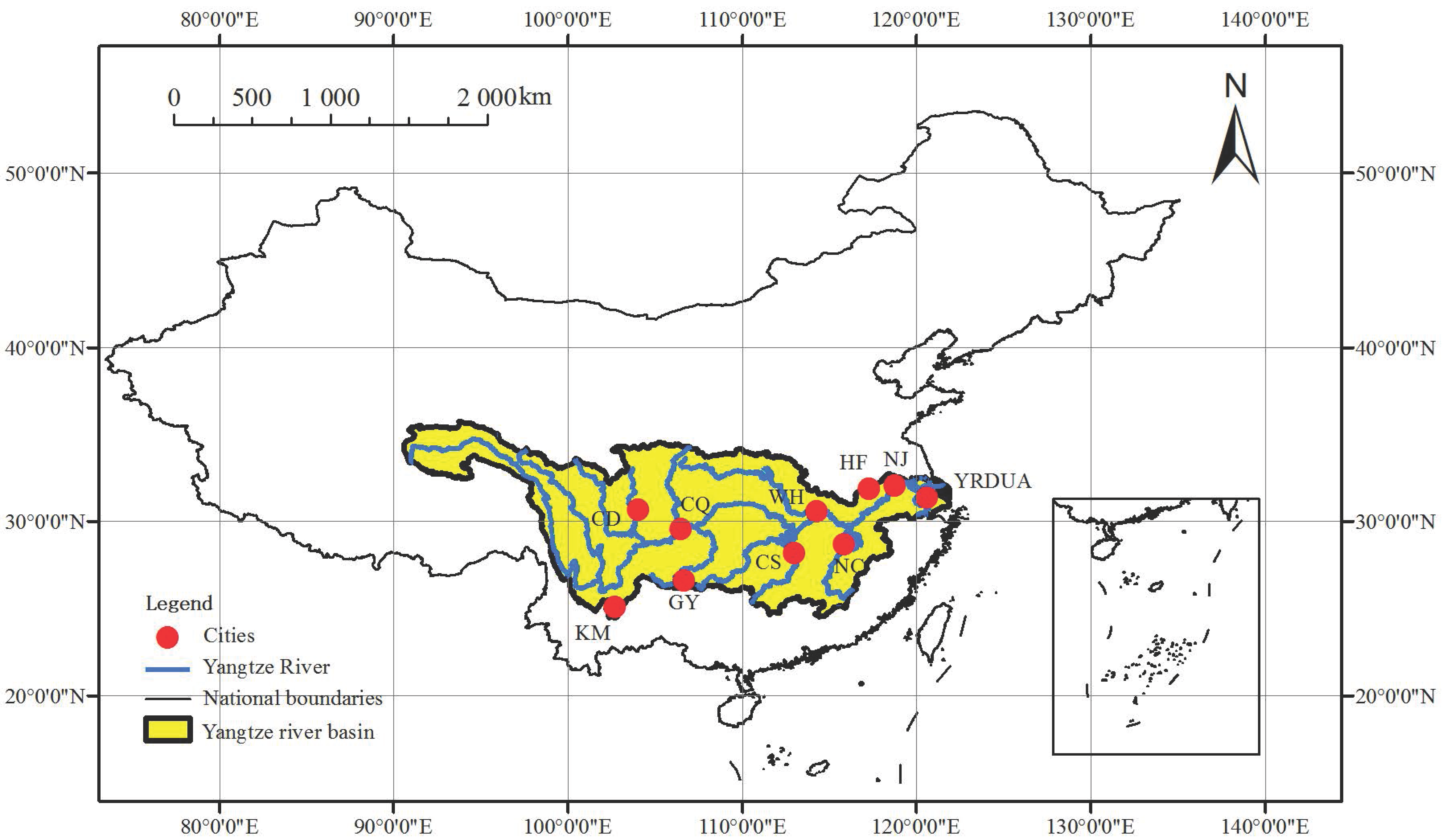
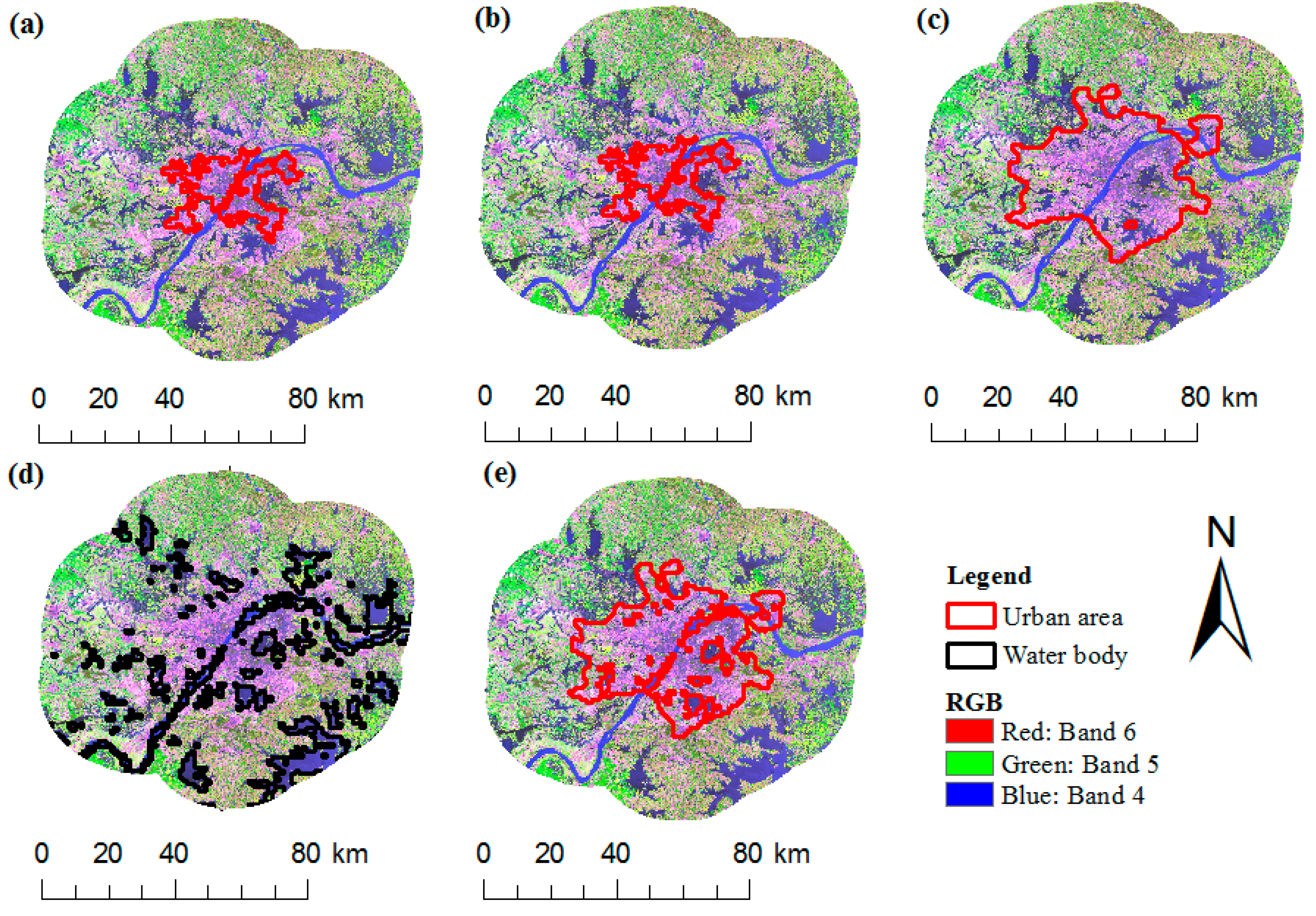
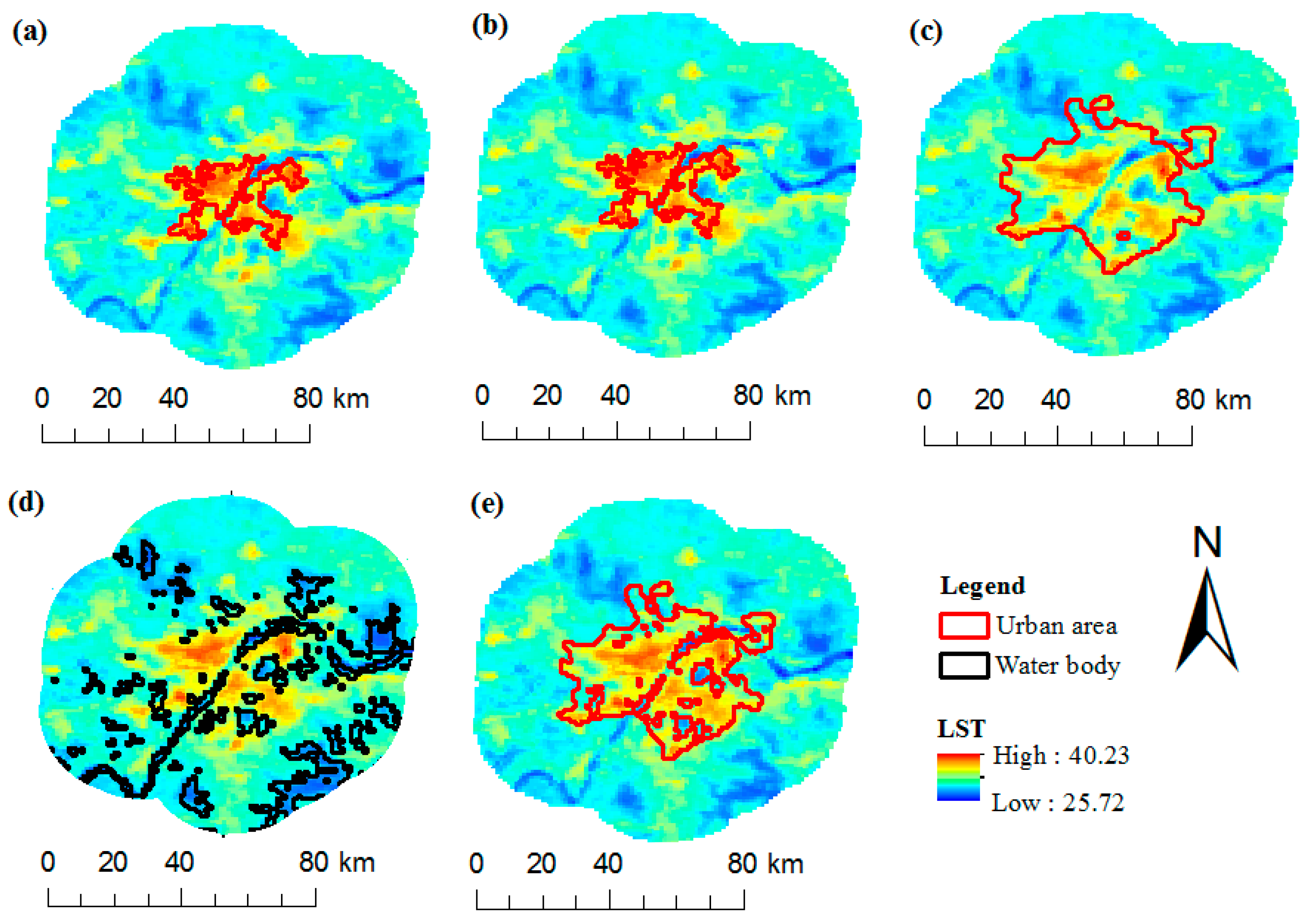
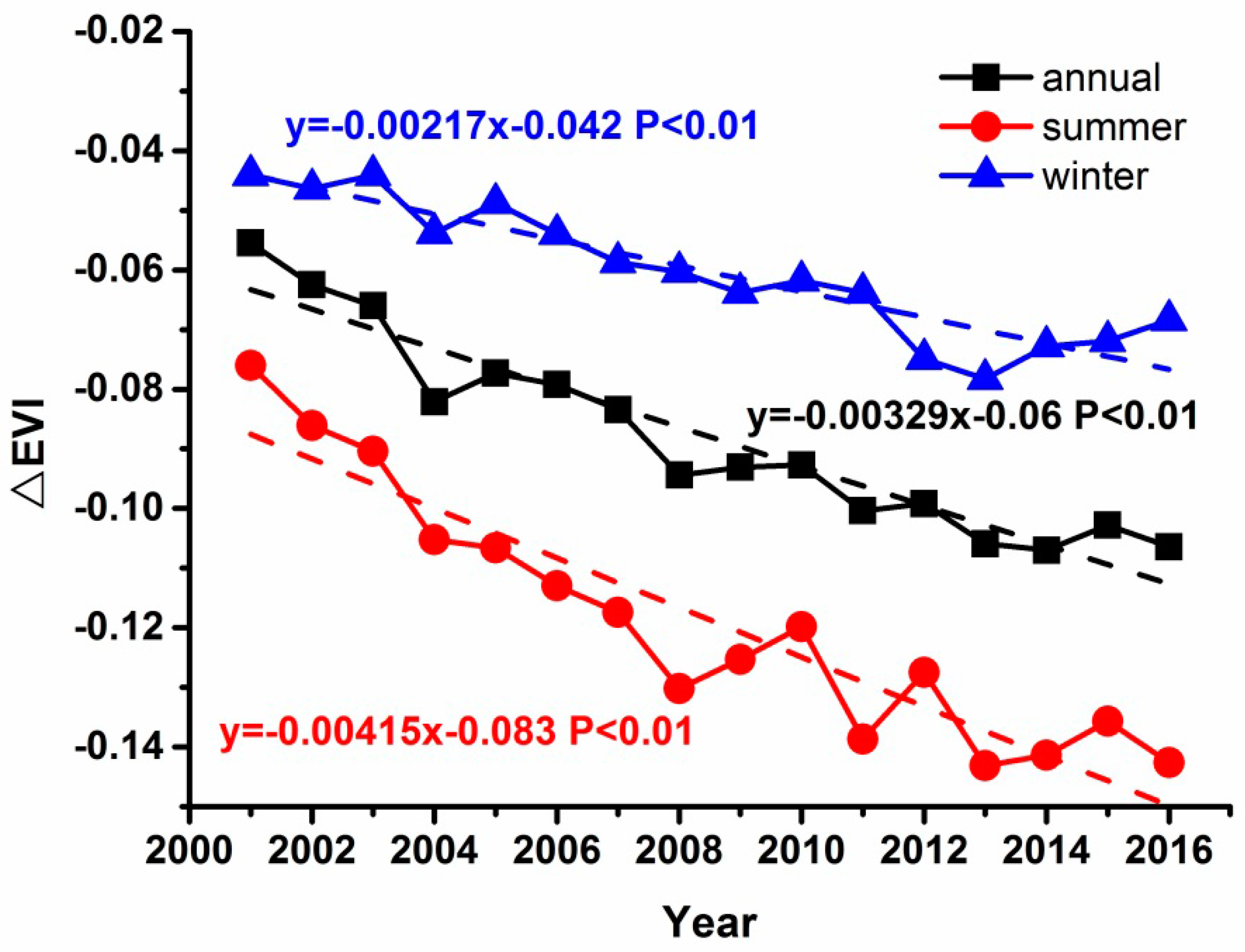

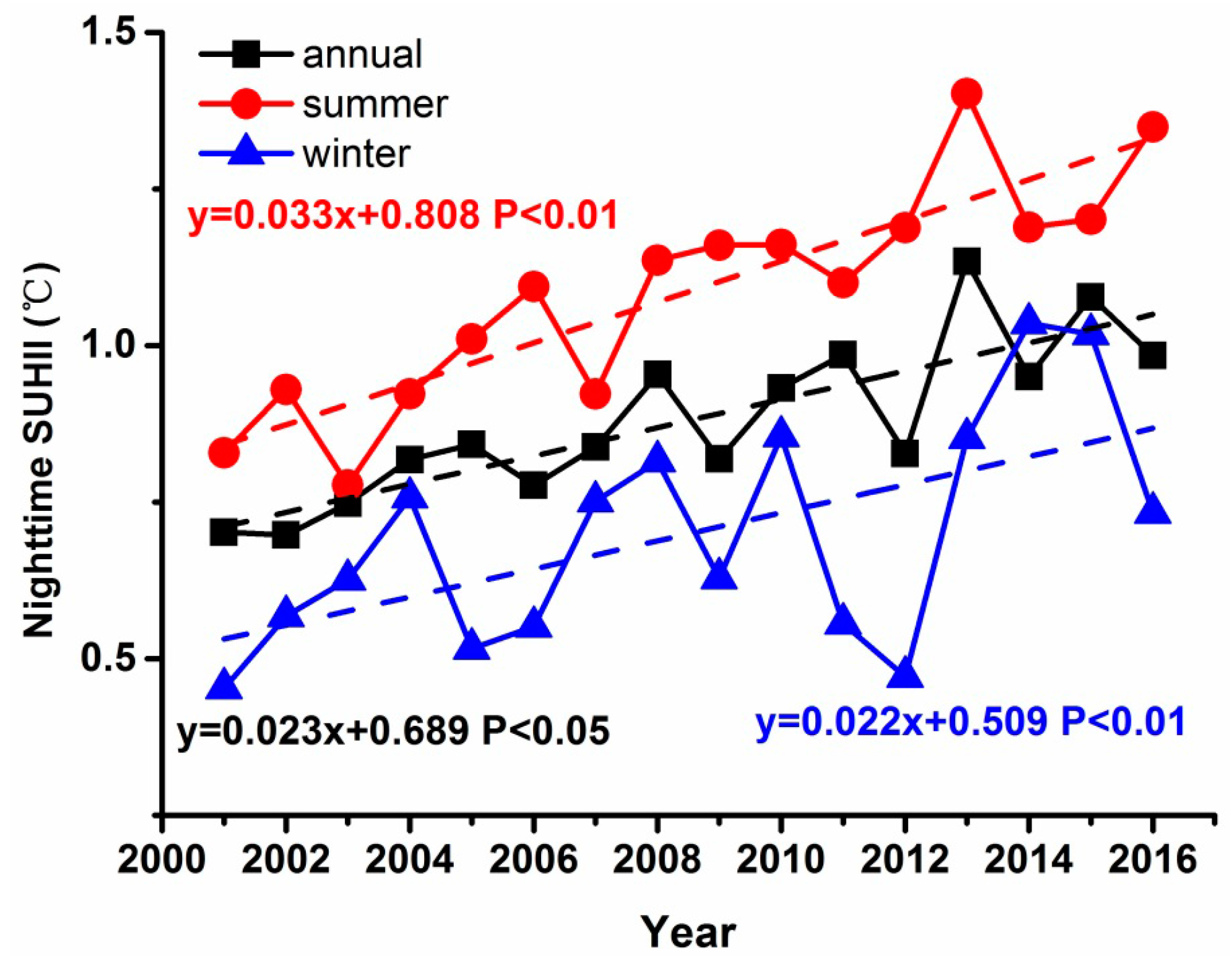

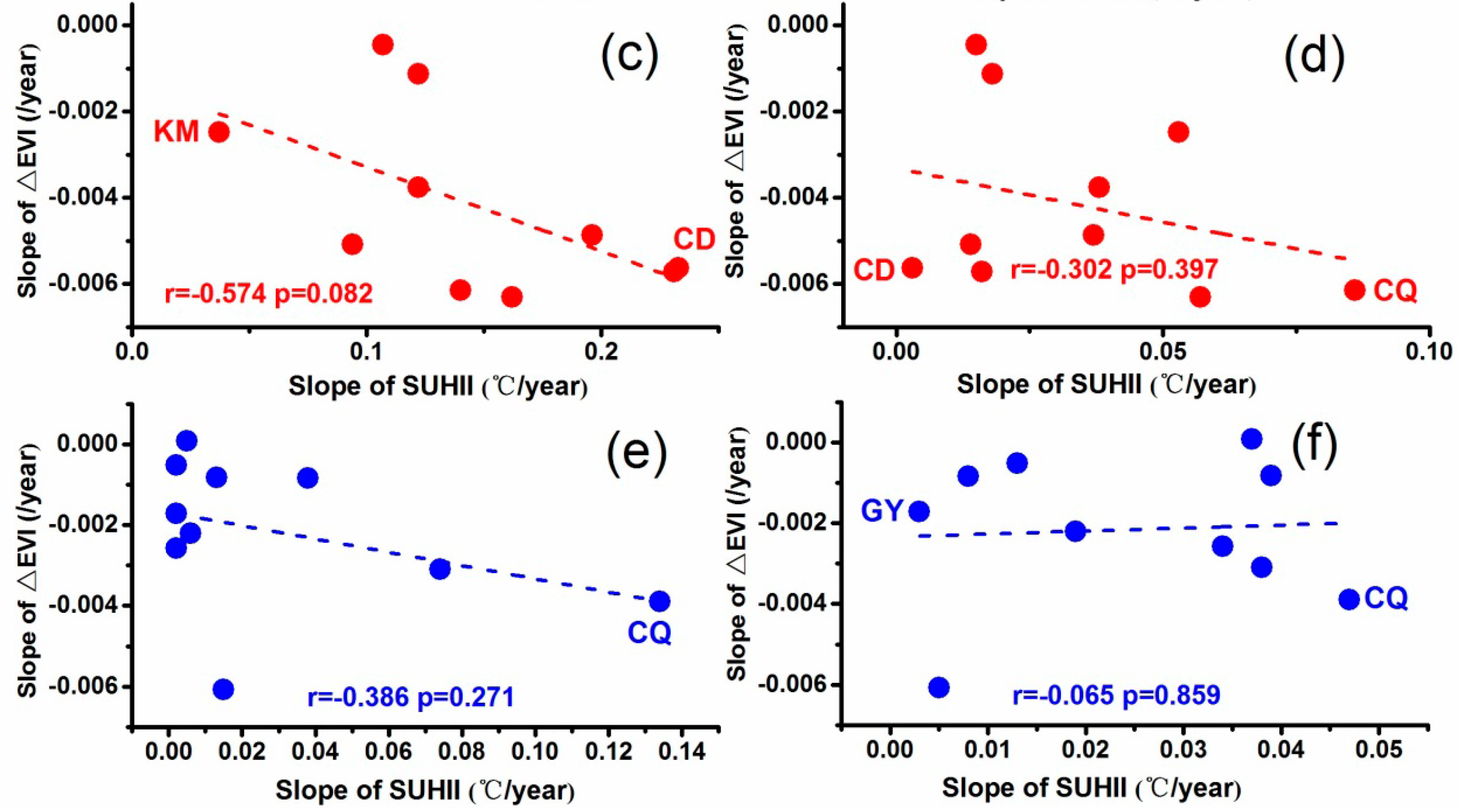
| Data | C1 | C2 | C3 | R2 |
|---|---|---|---|---|
| F142001 | −0.0176 | 2.0892 | −0.8501 | 0.96 |
| F142002 | −0.0131 | 1.7978 | 0.302 | 0.96 |
| F142003 | −0.0147 | 1.888 | 0.7129 | 0.96 |
| F152001 | −0.0109 | 1.6914 | −1.3106 | 0.94 |
| F152002 | −0.0066 | 1.4128 | −0.5183 | 0.94 |
| F152003 | −0.0182 | 2.1077 | 0.22 | 0.94 |
| F152004 | −0.0178 | 2.0849 | 0.1465 | 0.96 |
| F152005 | −0.0173 | 2.0518 | 0.397 | 0.94 |
| F152006 | −0.0158 | 1.9692 | 0.066 | 0.96 |
| F152007 | −0.0186 | 2.1455 | 0.235 | 0.98 |
| F162004 | −0.0141 | 1.8747 | −0.6434 | 0.94 |
| F162005 | −0.021 | 2.2854 | −0.9842 | 0.95 |
| F162006 | −0.0133 | 1.8456 | −0.8746 | 0.96 |
| F162007 | −0.0098 | 1.6158 | −0.4421 | 0.96 |
| F162008 | −0.0105 | 1.6601 | −0.6306 | 0.96 |
| F162009 | −0.0121 | 1.7534 | 0.4396 | 0.97 |
| F182010 | 0 | 1 | 0 | 1.00 |
| F182011 | −0.0037 | 1.2136 | 0.7621 | 0.97 |
| F182012 | −0.0013 | 1.0635 | 0.5368 | 0.98 |
| F182013 | −0.0006 | 1.0114 | 1.869 | 0.97 |
| YRDUA | NJ | HF | WH | CS | NC | CQ | CD | KM | GY | |
|---|---|---|---|---|---|---|---|---|---|---|
| 2001 | 3376 | 489 | 193 | 453 | 191 | 118 | 277 | 387 | 298 | 85 |
| 2002 | 4313 | 646 | 259 | 499 | 216 | 169 | 296 | 423 | 308 | 92 |
| 2003 | 5813 | 842 | 311 | 579 | 312 | 292 | 381 | 598 | 329 | 249 |
| 2004 | 6767 | 948 | 344 | 667 | 390 | 331 | 438 | 677 | 352 | 255 |
| 2005 | 7831 | 1003 | 378 | 748 | 405 | 334 | 489 | 711 | 392 | 259 |
| 2006 | 8389 | 1013 | 413 | 763 | 441 | 341 | 547 | 867 | 423 | 259 |
| 2007 | 8919 | 1077 | 516 | 863 | 521 | 393 | 566 | 909 | 463 | 259 |
| 2008 | 9788 | 1128 | 594 | 893 | 537 | 418 | 568 | 934 | 492 | 259 |
| 2009 | 9840 | 1130 | 602 | 893 | 538 | 418 | 585 | 1100 | 596 | 275 |
| 2010 | 10,847 | 1261 | 690 | 932 | 557 | 429 | 587 | 1248 | 616 | 281 |
| 2011 | 11,873 | 1359 | 763 | 1031 | 568 | 448 | 587 | 1258 | 627 | 299 |
| 2012 | 11,945 | 1360 | 764 | 1031 | 575 | 448 | 614 | 1258 | 680 | 299 |
| 2013 | 13,073 | 1443 (1335) | 844 (584) | 1339 (1088) | 790 (554) | 533 (410) | 808 (716) | 1591 (1317) | 727 (571) | 385 (295) |
| City | Annual | Summer | Winter |
|---|---|---|---|
| CD | −0.074 | −0.092 | −0.060 |
| CS | −0.106 | −0.153 | −0.072 |
| CQ | −0.101 | −0.157 | −0.069 |
| GY | −0.082 | −0.115 | −0.044 |
| HF | −0.082 | −0.100 | −0.055 |
| KM | −0.115 | −0.126 | −0.105 |
| NC | −0.088 | −0.122 | −0.051 |
| NJ | −0.069 | −0.099 | −0.043 |
| WH | −0.093 | −0.137 | −0.064 |
| YRDUA | −0.071 | −0.087 | −0.042 |
| Average | −0.088 | −0.119 | −0.060 |
| City | Annual Day (°C) | Annual Night (°C) | Summer Day (°C) | Summer Night (°C) | Winter Day (°C) | Winter Night (°C) |
|---|---|---|---|---|---|---|
| CD | 2.26 | 0.71 | 3.00 | 1.28 | 1.13 | 0.80 |
| CS | 1.47 | 0.56 | 3.29 | 1.12 | −0.16 | 0.08 |
| CQ | 1.70 | 0.81 | 3.02 | 1.51 | 0.46 | 0.27 |
| GY | 1.96 | 1.26 | 2.79 | 1.57 | 1.04 | 0.60 |
| HF | 1.43 | 0.29 | 2.79 | 0.45 | 0.08 | −0.07 |
| KM | 2.69 | 1.83 | 4.49 | 2.36 | 1.38 | 1.25 |
| NC | 1.18 | 0.72 | 3.37 | 0.82 | −0.33 | 0.88 |
| NJ | 1.15 | 0.76 | 2.77 | 0.30 | 0.06 | 0.95 |
| WH | 0.71 | 0.84 | 2.43 | 0.76 | −0.46 | 0.84 |
| YRDUA | 1.75 | 1.02 | 2.74 | 0.70 | 0.87 | 1.39 |
| Average | 1.63 | 0.88 | 3.07 | 1.09 | 0.41 | 0.70 |
| City | Annual (/Year) | Summer (/Year) | Winter (/Year) |
|---|---|---|---|
| CD | −0.00538 ** | −0.00563 ** | −0.00607 ** |
| CS | −0.00460 ** | −0.00630 ** | −0.00310 ** |
| CQ | −0.00529 ** | −0.00614 ** | −0.00390 ** |
| GY | −0.00336 ** | −0.00508 ** | −0.00171 ** |
| HF | −0.00392 ** | −0.00572 ** | −0.00220 |
| KM | −0.00308 ** | −0.00247 | −0.00257 ** |
| NC | −0.00216 | −0.00487 ** | −0.00083 |
| NJ | −0.00110 ** | −0.00044 | 0.00009 |
| WH | −0.00189 ** | −0.00376 ** | −0.00084 |
| YRD | −0.00211 ** | −0.00113 | −0.00051 |
| Average | −0.00329 ** | −0.00415 ** | −0.00217 ** |
| City | Annual Daytime SUHII (°C/Year) | Annual Nighttime SUHII (°C/Year) | Annual ∆EVI (/Year) |
|---|---|---|---|
| CD | 0.020 | 0.020 | −0.00285 ** |
| CS | 0.045 ** | 0.052 ** | −0.00303 ** |
| CQ | 0.082 ** | 0.053 ** | −0.00388 ** |
| GY | 0.027 | 0.006 | −0.00229 ** |
| HF | 0.014 | 0.065 ** | −0.00276 ** |
| KM | 0.029 | 0.024 ** | −0.00148* |
| NC | 0.029 * | −0.003 | −0.00154 ** |
| NJ | 0.031 * | 0.025 | −0.00017 |
| WH | 0.033 | 0.012 | −0.00126 * |
| YRD | 0.033 | 0.014 | −0.00160 * |
| Average | 0.034 ** | 0.027 ** | −0.00209 ** |
| City | Annual Day (°C/Year) | Annual Night (°C/Year) | Summer Day (°C/Year) | Summer Night (°C/Year) | Winter Day (°C/Year) | Winter Night (°C/Year) |
|---|---|---|---|---|---|---|
| CD | 0.107 ** | 0.014 | 0.233 ** | 0.003 | 0.015 | 0.005 |
| CS | 0.099 ** | 0.040 ** | 0.162 ** | 0.057 ** | 0.074 * | 0.038 |
| CQ | 0.117 ** | 0.041 ** | 0.140 ** | 0.086 ** | 0.134 ** | 0.047 ** |
| GY | 0.040 * | 0.018 | 0.094 ** | 0.014 | 0.002 | 0.003 |
| HF | 0.100 ** | 0.036 ** | 0.231 ** | 0.016 | 0.006 | 0.019 |
| KM | 0.034 * | 0.036 ** | 0.037 | 0.053 ** | 0.002 | 0.034 ** |
| NC | 0.075 ** | 0.004 | 0.196 ** | 0.037 * | 0.013 | 0.039 |
| NJ | 0.062 ** | 0.018 | 0.107 ** | 0.015 | 0.005 | 0.037 * |
| WH | 0.068 ** | 0.001 | 0.122 ** | 0.038 * | 0.038 ** | 0.008 |
| YRDUA | 0.072 ** | 0.007 | 0.122 * | 0.018 | 0.002 | 0.013 |
| Average | 0.077 ** | 0.033 ** | 0.144 ** | 0.023 ** | 0.029 ** | 0.022 * |
| City | Annual Day | Annual Night | Summer Day | Summer Night | Winter Day | Winter Night |
|---|---|---|---|---|---|---|
| CD | −0.882 ** | −0.236 | −0.953 ** | −0.203 | 0.006 | 0.106 |
| CS | −0.887 ** | −0.702 ** | −0.873 ** | −0.710 ** | −0.438 | −0.715 ** |
| CQ | −0.895 ** | −0.709 ** | −0.912 ** | −0.828 ** | 0.388 | −0.621 * |
| GY | −0.474 | −0.301 | −0.315 | −0.181 | −0.266 | −0.149 |
| HF | −0.869 ** | −0.682 ** | −0.896 ** | −0.155 | 0.056 | 0.099 |
| KM | −0.598 * | −0.886 ** | −0.364 | −0.372 | −0.144 | −0.749 ** |
| NC | −0.442 | −0.368 | −0.810 ** | −0.529 * | 0.450 | −0.612 * |
| NJ | −0.560 * | −0.512 * | −0.348 | 0.207 | 0.005 | −0.238 |
| WH | −0.618 * | −0.237 | −0.637 ** | −0.693 ** | −0.287 | −0.490 |
| YRD | −0.672 ** | −0.360 | −0.406 | −0.544 * | 0.103 | −0.076 |
| Average | −0.932 ** | −0.859 ** | −0.919 ** | −0.877 ** | −0.696 ** | −0.547 * |
© 2017 by the authors. Licensee MDPI, Basel, Switzerland. This article is an open access article distributed under the terms and conditions of the Creative Commons Attribution (CC BY) license (http://creativecommons.org/licenses/by/4.0/).
Share and Cite
Yao, R.; Wang, L.; Gui, X.; Zheng, Y.; Zhang, H.; Huang, X. Urbanization Effects on Vegetation and Surface Urban Heat Islands in China’s Yangtze River Basin. Remote Sens. 2017, 9, 540. https://doi.org/10.3390/rs9060540
Yao R, Wang L, Gui X, Zheng Y, Zhang H, Huang X. Urbanization Effects on Vegetation and Surface Urban Heat Islands in China’s Yangtze River Basin. Remote Sensing. 2017; 9(6):540. https://doi.org/10.3390/rs9060540
Chicago/Turabian StyleYao, Rui, Lunche Wang, Xuan Gui, Yukun Zheng, Haoming Zhang, and Xin Huang. 2017. "Urbanization Effects on Vegetation and Surface Urban Heat Islands in China’s Yangtze River Basin" Remote Sensing 9, no. 6: 540. https://doi.org/10.3390/rs9060540








